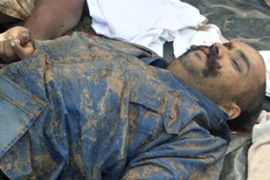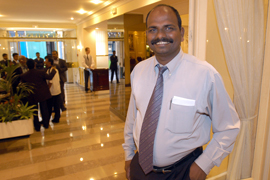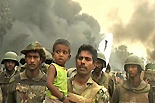Sri Lanka rebel chief ‘killed’
Colombo says conflict has ended successfully with deaths of senior Tamil Tiger figures.

At an official ceremony in the capital, Colombo, Sri Lanka’s defence secretary declared the end of the 26-year conflict with the LTTE, also known as the Tamil Tigers.
“We have successfully ended the war,” Gotabhaya Rajapakse told Mahinda Rajapakse, the president and commander-in-chief of the Sri Lankan armed forces.
‘Shot while fleeing’
| In video |
|
|
Military sources said Prabhakaran’s body was found in an ambulance destroyed by troops as it sped out of the war zone.
Al Jazeera’s Minelle Fernandez, reporting from Colombo, said that it was unclear how Prabhakan had been killed, if indeed he was dead.
“There are stories that the army fired an RPG at a vehicle carrying Prabhakaran and two other senior leaders and there are reports that he was shot while fleeing.”
If he is confirmed to have been killed it would “spell the end of the organisation that has been built almost around the cult of Prabhakaran”, she said.
“It is a surprise that it has fallen and literally brought to its knees and been defeated this quickly.”
Officials said that Prabhakaran’s corpse had been badly burned and DNA tests and other tests would be carried out on the body.
Chamari Danansuriya, a magistrate, described the process as a legal formality.
Leaders found dead
The reports of Prabhakaran’s death came just hours after the military said it had found the bodies of four other senior Tamil Tigers, including the LTTE chief’s 24-year-old son Charles Anthony.
 |
| Puleedevan was among the senior officials reportedly killed by the army [File: AFP] |
Balasingham Nadesan, the head of the political wing, Seevaratnam Puleedevan, secretary-general of the LTTE peace secretariat, and S Ramesh, the separatists’ eastern leader, were also killed, Brigadier Udaya Nanayakkara, the Sri Lankan military spokesman, said.
The defence ministry said troops also killed Prabhakaran’s deputies – Soosai, the leader of the Sea Tigers, and Pottu Amman, the LTTE’s intelligence chief.
There has been no comment from the LTTE on the claims.
Al Jazeera’s Tony Birtley said: “The conventional guerrilla fighting forces of the Tamil Tigers is probably now finished.
“Depending on what happens in the peace process, the fear is that this may develop into guerrilla war again … but what about the peace? There are not many left to talk to.
“A lot of mistrust has developed over the years; I think that’s the reason why this conflict began. Now it’s a problem that both sides have to make themselves understood.”
The Tamil Tigers had been striving to carve out a separate homeland for ethnic Tamils in the country’s north and east. They accused the Sinhalese-dominated government in Colombo of neglecting Tamils.
Bloody conflict
| Focus: Sri Lanka |
  Q&A: Sri Lanka’s civil war Q&A: Sri Lanka’s civil war The history of the Tamil Tigers The history of the Tamil Tigers Timeline: Conflict in Sri Lanka Timeline: Conflict in Sri Lanka |
The military had refused to accept a ceasefire from the Tamil Tigers, which had offered to lay down its arms on Sunday, declaring that its battle with the government had come to a “bitter end”.
The government maintains that the tens of thousands of civilians who had been trapped in the small area of conflict in the northeast of the country had finally been able to leave on Sunday.
Far from the battlefield, thousands of Sri Lankans hugged soldiers, waved flags, set off firecrackers and danced to the beat of traditional drums in the streets of Colombo, celebrating the end of the conflict.
The government and the Tigers alike have been criticised for not allowing civilians to leave the conflict zone.
More than 70,000 people have been killed in the conflict that started in 1983 and the UN says 6,000 were killed and hundreds of thousands displaced in just the last four months.
The Tamil Tigers once controlled nearly a fifth of the Indian ocean island nation, running a shadow state that had courts, police and a tax system along with an army, navy and even nascent air force.
